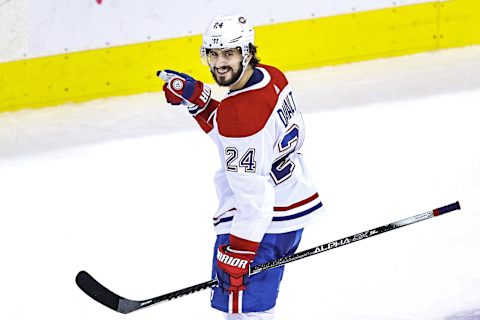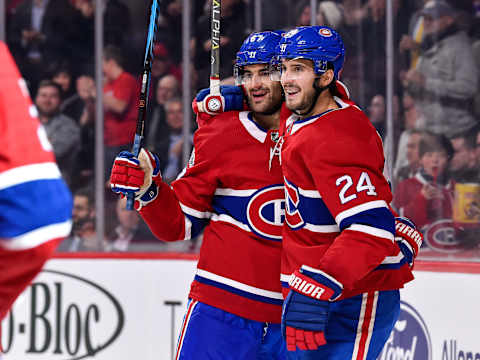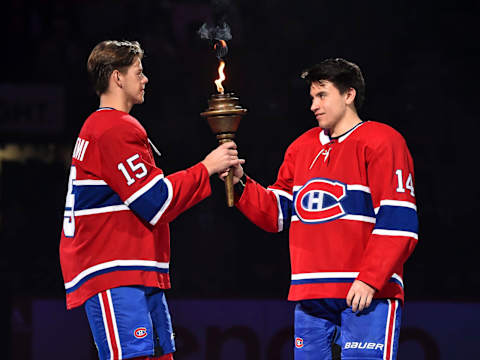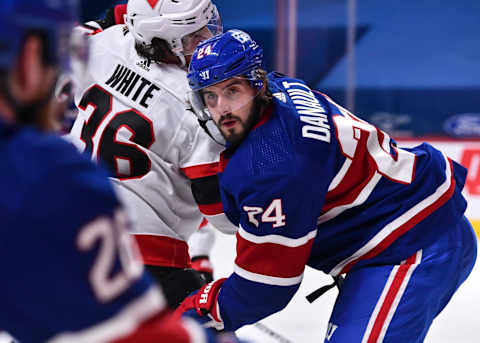Montreal Canadiens: The Danault Dilemma


Montreal Canadiens general manager Marc Bergevin, made one of his biggest heists (unknown at the time) in 2016.
Montreal acquired Phillip Danault and a 2018 second-round draft pick (which became Alexander Romanov) from the Chicago Blackhawks in exchange for forwards Dale Weise and Tomas Fleischmann. Regarded as a minor move at the time that helped both teams, it quickly turned in Montreal’s favour.
Tomas Fleischmann went on to play 19 regular season games and four playoff games with the Blackhawks and has not played a single NHL game since. Dale Weise played 15 regular season games and four playoff games with Chicago before signing a multi-year deal with the Philadelphia Flyers. He was reacquired by the Canadiens three years later.
After an average end to his 2015 campaign, Philip Danault took no time at all to carve out his role in Montreal’s top – six and emerged as a premier 200 foot player in the league. He recorded a career high in goals and points in 2017 with 40 points in 82 games, only to top that in 2019 with 53 points in 81 games. Danault was always considered a good two way player who fell under the radar, but it wasn’t until his last couple of seasons that he received more recognition around the league.
In 2019-2020, Danault finished 6th in Selke voting.
With at least 700 minutes played, Danault finished the 2020 campaign winning 54.12% of his draws in the defensive zone and averaging more starts there than players such Anze Kopitar, Ryan O’Reilly, and Sean Couturier. Despite facing this difficult defensive deployment in the league, he still managed to finish with an impressive 59.37CF% (Corsi-For) and 59.94xGF% (Expected Goal For Percentage) once again ahead of Couturier, O’Reilly, Kopitar as well as Mark Stone and Patrice Bergeron.
After 2020 Danault was starting to gain more notoriety around the league. In fact, in early January, Nathan MacKinnon was asked (on Barstool’s Spittin’ Chiclets) who he thought was a pain to play against, and he mentioned Philip Danault right away.
‘Such a good centreman. It’s hard to get space on him. I don’t know if he’s in Selke talks but he should be, hopefully he wins one. Good versus everyone, not just me.’ -Nathan MacKinnon

Inflated Offensive Numbers?
Danault has often been accused of being opportunistic. When Galchenyuk was struggling as a center in 2016, Danault was given first line duties with offensive wingers in Alexander Radulov and Max Pacioretty. He put up 40 points that season which most credited to his offensive wingers, not him. Once Pacioretty was dealt to the Vegas Golden Knights and Radulov signed in Dallas, Danault remained the first line center and had Tatar and Gallagher on his wings.
Philip Danault with Tomas Tatar and Brendan Gallagher on his flanks has become one of the better lines in the NHL. In 2020, that first line on Montreal had some of the toughest defensive assignments in the league, but still scored 58% of the goals and controlled 62% of the expected goals.
Danault gets criticized for his lack of offensive upside and awareness. He thrives at 5-on-5 and dominates possession, especially with intense play drivers in Gallagher and Tatar, but how much of his production has been inflated because of those wingers? If Danault played on the third line with Arturri Lehkonen and Joel Armia, would he come close to 40 points?
He is a good skater and handles the puck well enough but in the offensive zone, his upside seems limited. He’s often a pass first player, especially this season as only 23.3% of Danault’s shot attempts are from high danger areas. This is 12% lower than last season’s mark of 35.3%. A significantly lower Corsi shows a player who either doesn’t want to shoot, or isn’t confident enough in his shot.
Since I've been inspired by finally learning how to use bar charts on Tableau, here are the worst finishers so far this year (by goals scored above expected per 60, min 150 TOI): pic.twitter.com/QAADSarSUh
— JFresh (@JFreshHockey) February 19, 2021

The Emergence of Canadiens youth
The Canadiens former 3rd overall pick Jesperi Kotkaniemi was expected to take bigger strides in his second year but did not do that. A sophomore season riddled with injuries and subpar play led to a significant dip in his totals. He tallied only eight points in 36 games, battled injuries and then was sent down to Laval where he scored 13 points in 12 games. In his absence, Nick Suzuki took little time to get noticed and had a very strong rookie year. Slowly climbing up the lineup, he finished the regular season with 41 points in 71 games and finished 9th in Calder voting.
Once Montreal made the ‘play ins,’ Kotkaniemi was finally healthy and made an immediate impact. He looked like a completely different player against Pittsburgh and Philadelphia. He was skating much better, wasn’t forcing plays, and played arguably his best hockey as a Canadien. Suzuki was able to build on his regular season success and was a lethal force from the get-go.
In the postseason, Kotkaniemi and Suzuki led the Canadiens in goals with four. Danault only had one in ten playoff games.
Suzuki finished the playoffs with 2nd most points/60 (behind Jonathan Drouin) with 2.19 while Kotkaniemi was 4th with 1.73.
Danault was 14th with 0.92.
Suzuki outscored Danault in the regular season and postseason in his rookie year. He refined his game throughout the year and forced his way into the first line center role in the playoffs. While he did not score at the rate Suzuki did, Kotkaniemi tallied four goals and had an impact beyond the scoresheet: dominating possession and creating chances.
The offensive weaknesses of Danault’s playoff performances were exacerbated in tight playoff checking hockey to the point where he ended up being moved to a pure defensive line with Paul Byron and Artturi Lehkonen. He did thrive in that role.

Contract Negotiations
Following the playoffs and strong play from Montreal’s young centers, Danault with just one year left on his contract, did not hold back his concerns about his future (and his role) in Montreal.
I don’t know if I’m ready for this honestly, I love producing offensively and have enjoyed my role the past two seasons. I don’t know if I want to limit myself to a specific role, which would only be defensive. I don’t think I will get better by playing just defensively. I’ve seen my role change during the playoffs, but with what I’ve proven in the last few years, my role shouldn’t change in Montreal, I have demonstrated that I am capable of playing both defensively and offensively. -Philip Danault
Mid January, it was reported that Danault declined a six-year, $30 million contract in the fall, per Mathias Brunett of La Presse. Many deemed this an extremely generous offer for someone who has only eclipsed the 50 point mark once and has never scored more than 13 goals in a single season.
If Kotkaniemi and Suzuki are to inevitably push him down the Canadiens depth chart, is it worth paying a defensive third line center $5 million per year over the next six years? Is it worth it for Danault to take it if he knows he won’t be the Canadiens’ number one center for the future? Turning down this money only to continue this subpar play makes it unlikely for him to get another offer like that again. Even if it does go up, how much term will he get? Marquee free agents in 2020 signed for less than projected. How will that change in 2021?
Danault’s frustration is understandable as no one wants to be pushed down the depth chart, but looking at the blueprint of Bergevin’s ‘reset’, Kotkaniemi and Suzuki are, or in theory “should be” the two pieces Bergevin looks to build around. Given the fact that some still argue that Trevor Timmins reached for Kotkaniemi in 2018, it is probably in their best interest to ensure he’s developing properly. That means playing him in the top six and letting him grow as the season goes on.
Danault’s future in Montreal depends on the play of the youth. If one of or both Kotkaniemi and Suzuki were to take considerable steps back this season, Bergevin might have an easier time bringing him back for a short term role in the top six. At the same time, Danault still might be hesitant knowing that Kotkaniemi and Suzuki are projecting to both be top six forwards in the long run, and as shown in the playoffs, he doesn’t want his role changed.

2020-2021 Season
With strong two-way play but underwhelming offensive results, the Tatar-Danault-Gallagher remained intact up until the 15th game of the season when Julien opted to scratch Tomas Tatar. Whether he deserved it or not might be up for debate, but the idea the line needs to be better is not. Bergevin made that clear in his press conference, saying he expects more from Danault and Tatar.
Danault has yet to score a goal through 15 games and has a mere six points.
Suzuki looks like he’s the Canadiens true number one center right now scoring at just under a point per game pace. Despite playing on the 3rd line, Kotkaniemi is still out producing Danault while averaging 13:47 per night, which is only 1:27 more than Jake Evan’s, Montreal’s lowest played forward.
Danault averages 17:09.
Here is how the three breakdown so far this season production wise:
Points/60
Suzuki: 2.64
Kotkaniemi: 2.18
Danault: 1.34
Goals/60
Suzuki: 0.66
Kotkaniemi: 0.29
Danault: 0
Assists/60
Suzuki: 1.98
Kotkaniemi: 1.74
Danault: 1.49
Shots/60
Suzuki: 6.38
Kotkaniemi: 8.73
Danault: 4.21
Future Negotiations
Marc Bergevin is in a peculiar situation moving into the trade deadline and offseason, and right now he has the following options:
- Keep Danault for a potential playoff run even if it means losing him in free agency.
- Maximize his value right now and recoup assets for him via trade.
- Sign and trade in the offseason
- Danault signs a team friendly deal
Next. Habs Headlines From Past Week. dark
Danault is what he is: a strong defensive center with some offensive upside to his game. How much upside is clearly up for debate. Being a top – six center right now doesn’t mean he’ll be one in the future, especially with Nick Suzuki and Jesperi Kotkaniemi knocking at the door. How he plays, if he accepts his role, and if he wants a future in Montreal ultimately depends on him.